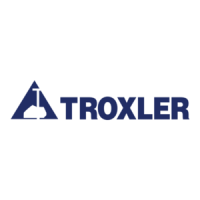
Do you have a question about the Troxler 3241 Series and is the answer not in the manual?
| Model | 3241 Series |
|---|---|
| Category | Measuring Instruments |
| Measurement Principle | Nuclear radiation detection |
| Measurement Parameters | Density (wet and dry), Moisture Content |
| Depth of Measurement | Up to 12 inches (30 cm) |
| Source Type | Cesium-137 (Cs-137) for density, Americium-241/Beryllium (Am-241/Be) for moisture |
| Display | Digital LCD |
| Battery Type | Rechargeable battery pack |
| Operating Temperature Range | 0° to 50°C (32° to 122°F) |
| Standards Compliance | ASTM D6938, AASHTO T310 |
| Measurement Range | Moisture: 0 to 60% |
| Calibration | Factory calibrated |
| Type | Nuclear Moisture Density Gauge |
| Applications | Density and moisture measurement of soils, asphalt, concrete and other materials |
Overview of the Model 3241 Series gauge and its function.
Procedures for receiving and checking all gauge components upon arrival.
Guidelines for choosing an appropriate location for the gauge.
Explanation of the nuclear method used for determining asphalt content.
Steps to connect and power up the gauge system correctly.
Initializing gauge settings like count time, date, and company name.
Procedure to establish a baseline count for accurate measurements.
Detailed steps for preparing asphalt-aggregate samples for testing.
Instructions for performing an asphalt content measurement.
List of necessary and suggested equipment for calibration.
Guide to creating calibration samples from aggregate and asphalt.
Techniques and tips for accurately mixing asphalt and aggregate for calibration.
Procedure for conducting a calibration using prepared samples.
How to recall and examine previously stored calibration data.
Steps to activate a previously saved calibration.
Method for inputting calibration constants directly into the gauge.
How to create, view, and manage projects for data organization.
Procedure for saving measurement data under a project.
Instructions for printing stored project or calibration data.
How to remove project data or calibrations from the gauge.
How to view the current gauge settings and status.
Method for adjusting existing calibrations for improved precision.
Configuring automatic data storage and printing.
Procedures for removing calibration data or projects from memory.
Retrieving and displaying the results of the last measurement.
Setting precision for automatic count time adjustment.
Using the built-in four-function calculator.
Function for entering calibration values and calculating sample weights.
Performing a test to validate gauge operation and stability.
Checking for long-term drift in gauge readings.
Attempting to recover inadvertently erased project data.
Changing the gauge's internal time and date settings.
Procedure to transfer calibration data between gauges.
Configuring communication speed for serial devices.
Setting a custom name or message for the gauge display.
Function to re-enter or verify the gauge's serial number.
Enabling the display of sample pan weights during measurement setup.
Explanation of radioactivity, atomic structure, and nuclear principles.
Definitions of key terms and units related to radiation measurement.
Discussion of statistical distributions in radiation emission.
General safety practices, exposure limits, and types of radiation.
Methods to minimize radiation exposure to users.
Precision data for the gauge based on source activity and count time.
Details on neutron source, shielding, and dose rates.
Information on time accuracy, power supply, display, and memory.
Physical dimensions, weight, and operating environmental limits.
Guidance for diagnosing and resolving common gauge operational problems.
Procedure for ensuring the integrity of the radioactive source encapsulation.
Instructions for properly charging the gauge's batteries.
List of part numbers for common replacement components.
Procedures and information required when sending the gauge for repair.
Regulations and procedures for safely transporting the gauge in the US.
Regulations and procedures for transporting the gauge in Canada.
Procedure for preparing sealed samples for calibration.
Template forms for recording calibration and sample preparation data.
